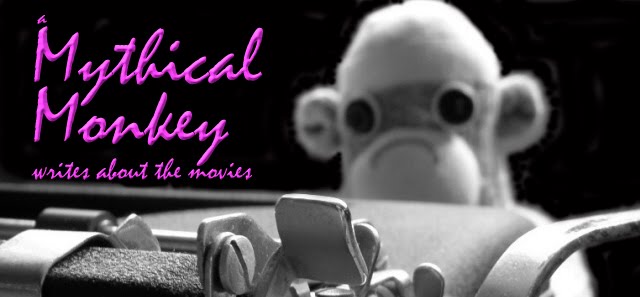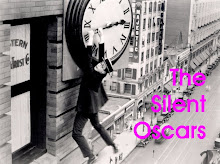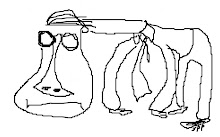Katie-Bar-The-Door is still out of town, so Mister Muleboy and I again met at the AFI-Silver, this time for the Charlie Chaplin talkie Limelight.
This was Chaplin's third sound picture and the last film he made in the United States. I guess everybody has their favorite Chaplin talkie — I assume most would choose The Great Dictator (1940), his savage spoof of Adolf Hitler, while others might go for Monsieur Verdoux (1947), a black comedy about a serial killer whose latest victim simply refuses to die.
Me, I prefer Limelight.
It's the story of an alcoholic has-been (Chaplin) who rescues a suicidal ballerina (Claire Bloom), nurses her back to health, gets her on her feet again. During the day, she talks about her troubles; at night he dreams of his past as London's greatest music hall comedian. Once she recovers, her career takes off while his continues to decline. Along the way, a love triangle of sorts develops, with the ballerina torn between her platonic devotion to Chaplin while falling deeply in love with a shy young composer (played in a nice Freudian twist by Chaplin's son Sydney).
Chief among the film's delights is the casting of Buster Keaton as his stage partner, the only time these two silent comedy legends appeared in a movie together. Both men were past their primes here — Chaplin hadn't had an unalloyed success since Modern Times in 1936 and Keaton's heyday was even more distant, with his peak years running from just 1920 to 1928 — and Keaton's appearance is not much more than a cameo. But boy, what a cameo.
In their scene together, Chaplin's has-been teams up with Keaton's has-been to perform a silent sketch where two clumsy musicians destroy a piano and a violin mid-concert. If you've ever seen Chaplin in, say, The Pawnshop or Keaton in The Boat, you know just how much damage these guys can do.
Chaplin always played well off an opposite number — think of Roscoe Arbuckle, Eric Campbell, Mack Swain and Harry Myers — and his and Keaton's contrasting styles, the clown and the stoneface, work especially well. For a few minutes, the two legends defy the passage of time and remind us of what made them so special in the first place.
The novelty of seeing the silent era's two greatest comics together at last would be enough to make the film worth watching, but Chaplin also revisits the Tramp in at least three scenes, albeit with a different moustache and a check vest. Sure, he's not twenty-five anymore, but he can still bring it.
There's something poignant about watching a fading legend facing his loss of talent, energy and inspiration so directly, and those scenes where the has-been looks out on an empty theater that once was filled with cheering fans must have been particularly haunting for Chaplin as his real-life audience deserted him. But Chaplin being Chaplin, he finds an answer: to inspire the next generation, the only immortality an artist ever really knows.
Nigel Bruce — better known as Dr. Watson to Basil Rathbone's Sherlock Holmes — turns in a good supporting performance as a theater manager, and there's a long ballet sequence reminiscent of The Red Shoes that I thought was quite beautiful. There's also a terrific silent gag about a high-end prostitute working the theater crowd that was worthy of Ernst Lubitsch.
Which is not to suggest that Limelight is a perfect film. Far from it. It suffers from the same flaw as all of Chaplin's sound pictures — he talks too much! In the silent era, Chaplin's Tramp could speak volumes with a single look. In the sound era, he simply speaks volumes. And frankly, as a moral philosopher, Chaplin is a hackneyed windbag.
Too, your opinion of Limelight depends on your willingness to tolerate Chaplin's return to the theme that haunted most of his work — his compulsive need to rescue damsels in distress. No doubt he was replaying, consciously or not, his boyhood situation with his mentally-ill mother, but the fact is, damsels who are chronically in need are beyond help, and the rest get better and move on, which suggests that the compulsion to rescue them is less about helping others and more about courting rejection and self-pity.
At least here, Chaplin at last finds the only solution to the dilemma that really works. I'll leave it to you to discover what that is.
Look, I'm not one of those people forever crabbing about Chaplin and sentimentality. Sentimentality is just a way of saying "an appeal to emotion rather than reason" and I happen to think that that's exactly what the movies are for, to bypass the frontal lobes and head straight for the lizard brain where love and anger and fear reside. If a movie can make me think, fine; but it had better make me feel something first or it's wasting my time.
My quibble here is that, at least where the ballerina's story is concerned, Chaplin more insists on the sentiment than actually creating it.
Still, the good far outweighs the bad.
I'd like to tell you that Limelight was a critical and commercial success, but the fact is, the film never received a proper release in the United States. When the film was completed, Chaplin boarded a boat to visit his home in England, and as soon as the ship cleared the harbor, the U.S. government declared Chaplin an undesirable alien and revoked his visa.
There were two types of anti-Communists in the 1940s and '50s: those seeking to best the Soviet Union in the existential struggle of the Cold War (e.g., Harry Truman, Dwight Eisenhower, George Kennan, George Marshall); and those seeking to destroy their political and personal enemies with scurrilous accusations (Joe McCarthy, HUAC). Chaplin was a victim of the latter. He wouldn't return to America for twenty years.
The odd situation with Limelight did lead to the answer to a trivia question that film fans often get wrong: name the movie for which Chaplin won a competitive Oscar. In 1972, fans of Chaplin realized Limelight had never played in Los Angeles, so they rented a theater for a week and screened it, making it eligible for an Oscar under the rules of the time. Chaplin's original score received a nomination and when the envelope was opened, Chaplin had won. It was a sentimental gesture, but then Chaplin was a sentimental man so it seems fitting.
Awards or no, though, Chaplin achieved his immortality — he continues to inspire artists and will for as long as films are shown.
Subscribe to:
Post Comments (Atom)















11 comments:
In the silent era, Chaplin's Tramp could speak volumes with a single look. In the sound era, he simply speaks volumes.
Now, having written that, and I wish I had, you have to dig old fuck-yeah Hemingway's short stories just a TAD? I sure do & most sure don't.
Funny you should mention Hemingway. A lot of what I think I know about writing came from a book by Carlos Baker called Hemingway: The Writer As Artist. Each chapter is a nuts-and-bolts analysis of one of Hemingway's books or short story collections. I'd read a chapter of Baker, then re-read the Hemingway, then try to apply the lessons to old drafts of my writing. Took most of a year.
It helped.
Which didn't really answer your question, did it, Who. Yeah, I'm a big fan of Hemingway. Nobody was ever better at conveying action in words than he was, and the whole business about carefully selecting details that would stand in for a greater whole is also brilliant. Informs my movie criticism -- whenever I get exasperated at someone for failing to get to the point, what I really mean is that the didn't find the one detail or telling action that would have short-circuited the need for several scenes worth of exposition.
what I really mean is that the didn't find the one detail or telling action that would have short-circuited the need for several scenes worth of exposition.
In Limelight, I think that Chaplin did find the one detail or telling action that would have short-circuited the need for several scenes worth of exposition. But, liking the sound of his own voice a lot, he felt the need to have minutes-long speeches pointing out what we'd already seen, or heard, or discerned. He would then give the same speech again later, in case we'd missed it.
And I liked the damned thing, and Chaplin's character, in spite of all that. . . !
P.S. I love Hemingway, but don't know that I necessarily would have if I hadn't begun with A Moveable Feast and worked my way backward.
'Twas the Monkey's recommendation that got me Hemingwayized.
I forgive him his romanticizing war. He was unrepentantly juvenile in his understanding of women, why not war too. . . ?
And I liked the damned thing, and Chaplin's character, in spite of all that. . . !
Me, too. The film is flawed, but it is warm and Chaplin seems aware of its flaws and knows they are chasing the last of his audience away, but he's going to speak his piece anyway. I kept my mouth shut for twenty-five years, he seems to be saying, now I've got to let it out.
I forgive him his romanticizing war. He was unrepentantly juvenile in his understanding of women, why not war too. . . ?
I completely get it when people say they don't like Hemingway -- what he knew about women wouldn't fill a thimble, and his thoughts on war and big-game hunting were passe by 1944.
Hemingway came up at home this weekend because the Washington Post Sunday magazine mentioned the so-called Hemingway App -- http://www.hemingwayapp.com/ -- which claims to analyze and grade your writing according to the Hemingway ideal. Ironically, Hemingway himself would flunk the Hemingway test.
Here's a bit from the story "The Short Happy Life of Francis Macomber":
The car was going a wild forty-five miles an hour across the open and as Macomber watched, the buffalo got
bigger and bigger until he could see the gray, hairless, scabby look of one huge bull and how his neck was a part
of his shoulders and the shiny black of his horns as he galloped a little behind the others that were strung out in
that steady plunging gait; and then, the car swaying as though it had just jumped a road, they drew up close and
he could see the plunging hugeness of the bull, and the dust in his sparsely haired hide, the wide boss of horn
and his outstretched, wide-nostrilled muzzle, and he was raising his rifle when Wilson shouted, "Not from the car,
you fool!" and he had no fear, only hatred of Wilson, while the brakes clamped on and the car skidded, plowing
sideways to an almost stop and Wilson was out on one side and he on the other, stumbling as his feet hit the still
speeding-by of the earth, and then he was shooting at the bull as he moved away, hearing the bullets whunk into
him, emptying his rifle at him as he moved steadily away, finally remembering to get his shots forward into the
shoulder, and as he fumbled to re-load, he saw the bull was down.
"Macomber" has everything in it that people hate about Hemingway -- the glorification of big-game trophy hunting, a woman reduced to the very cartoon of a adulterous, murdering shrew -- but it also contains this very fine example of how to convey action with words. You could teach an entire course on writing based on this one sentence alone.
The Hemingway App grades the above sentence as "Bad" -- a 56 on a scale of 1 to 60, with 1 being best and 60 being worst -- noting that it is "very hard to read" and has a couple of adverbs which it considers to be a no-no per se.
Which is why the Hemingway App is a load of crap.
A few of my early songs scored "100" on The Beatles App -- which tells you how fucked all of those apps are.
By the way, there is no Beatles App -- I am like Chaplin, I like to [read] the sound of my own voice. . . .
I knew it. I just fricking KNEW it. And I'm so happy I'm not alone in it. :-)
Most of the people I've met who dislike Hemngway's writing actually dislike Hemingway. They probably also say "Love and Death isn't a funny movie" for similar reasons.
Back to Limelight -- last night in the sixth episode of the sixth series of Dr. Martin, Doc Martin's mom showed up at his front door. Over a year after telling him that she wished she'd never had him.
The actress has been brilliant in portraying a cold, cold, cold, heartless woman.
Said actress? Claire Bloom.
btw, she does not look old enough to have acted with Chaplin in Limelight as an adult character -- she has aged awfully well.
Post a Comment